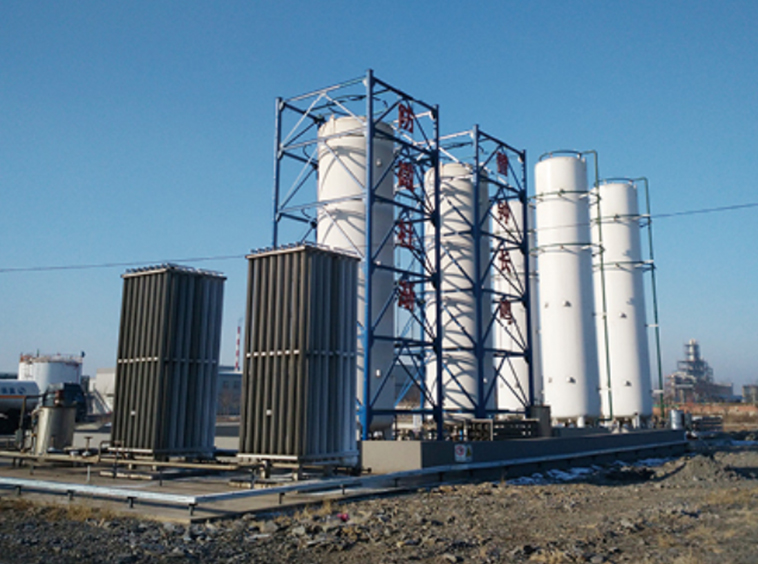Name: Jiangsu Jianye Chemical Equipment Co., Ltd.
Contact: Liu Yong
Phone:0512-58370568
Mobile:13806225925
Fax:0512-58371568
Mailbox:ly925@jylng.cn
Address: Sanjiali Road, Nansha, Jingang Town, Zhangjiagang City
Website:en.jylng.cn
Overview:
1. Product Name: Cryogenic liquid storage tank
Filling medium: LO2/LN2/ LAr/LNG
Physical properties of the medium:
Liquid nitrogen (LN2)
Average molecular weight: 28.01
Gasification temperature: -195.750C
Liquid phase density: 810kg/m3
Liquid nitrogen is a cryogenic liquid (at 101.325KPa, liquid nitrogen boiling point is -195.75 ° C), causing frostbite (cold burn) when in contact with human skin and eyes. When the cryogenic liquid is vaporized into a gas, the volume expands rapidly (at 0 ° C, 101.325 KPa, 1 L of liquid nitrogen is vaporized to 648 L of gas). In a closed container, the pressure is increased due to volume expansion, which may cause the container to overpressure and explode.
Nitrogen is a colorless, odorless, odorless gas. At normal temperature, the chemical nature of nitrogen is not active. It is a gas that can suffocate people or animals.

Liquid oxygen (LO2)
Average molecular weight: 32
Gasification temperature: -1830C
Liquid phase density: 1140kg/m3
* Liquid oxygen and oxygen are a strong oxidant and a strong combustion improver.
* Liquid oxygen is close to combustible materials, which can easily cause fire to burn.
* When liquid oxygen comes into contact with combustible materials, it will explode due to impact. When liquid oxygen is mixed with combustible materials, there is a danger of explosion.
* When liquid oxygen evaporates into oxygen, it can be adsorbed by fabrics such as clothes, and it is easy to cause flashing combustion in case of fire.
Liquid argon (LAr)
Average molecular weight: 39.95
Gasification temperature: -185.70C
Liquid phase density: 1410kg/m3
Argon is a rare gas. It is also a colorless, odorless, non-toxic, non-flammable inert gas that has suffocation and anesthesia.
2, design, manufacturing technical specifications
TSG R0004-2009 "Safety Technical Supervision Regulations for Fixed Pressure Vessels"
GB150.1~150.4-2011 "Pressure vessel"
GB/T18442.1~ 18442.6-2011 "Fixed vacuum insulated cryogenic pressure vessel"
Designed for 20 years
3. Non-destructive testing of weld seams in low temperature storage tanks
Class A and Class B 100% RT, according to JB/T4730.2-2005, the level of radiographic inspection technology is not lower than Class AB, the qualification level is not lower than Class II, and 100% PT, qualified according to JB/T4730.5-2005I. .
20% RT, according to JB/T4730.2-2005, the technical level of radiographic inspection is not lower than Grade AB, and the qualification level is not lower than Grade III; finally, the seam is 100% UT, and pulse reflection is required according to JB/T4730.3-2005. Ultrasonic testing, the detection technology level is not lower than Grade B, and the qualification level is not lower than Grade I.
C, D, E stainless steel and stainless steel (low alloy steel) need to be 100% PT, qualified according to JB/T4730.5-2005I, the remaining 100% MT, qualified according to JB/T4730.4-2005I (enclosure and reinforcement) Except for welded joints between the rings)
4. Main structural features and process description
Main structural features
Vacuum insulation is used, and the heat insulating material is pearl sand.
The top liquid filling design has a porous priming structure that allows the cryogenic liquid to be kept quiet when it is filled into the inner container. A part of the gas phase in the inner vessel can be liquefied by low temperature absorption to maintain the relative stability of the gas phase pressure of the inner vessel during the filling process.
The support structure between the inner liner and the outer casing is supported by the upper stainless steel tube with a lower stainless steel tube. Under the normal working position of the equipment (vertical), the gravity load of the inner tank and its storage medium is transmitted to the outer casing through three stainless steel pipes, and finally transmitted to the outer casing legs and the equipment foundation to avoid additional eccentric moment load, the structure At the same time, it ensures the need for the bladder to shrink freely under low temperature conditions.
The low temperature pipeline is concentratedly taken out from the lower end of the tank for easy operation and maintenance. In order to ensure the stable and safe storage of the cryogenic liquid, the tank is provided with multiple safety devices and instruments: a liquid level gauge, a pressure gauge, an explosion-proof device for the outer cylinder, a combined safety system, and a pipeline. Safety valve, etc.
5, process description
Low temperature storage tank gas displacement treatment
The tank must be gas-substituted before it is used for the first time, and the air in the tank and the tank can be replaced by a nitrogen purge.
Voltage regulation and troubleshooting
Open the booster input valve to increase the pressure in the tank. If an emergency is found, open the gas discharge valve to relieve pressure. Under working conditions, once the tank is overpressured, it can be relieved by a safety valve and a rupture disc.
measuring
According to the reading of the level gauge, the actual loading volume of the tank can be read by referring to the liquid level comparison table; the working pressure of the tank can be read according to the pressure gauge; if the tank pressure rises abnormally during the tank maintenance or during the operation The vacuum of the interlayer can be measured by a vacuum thermocouple gauge.